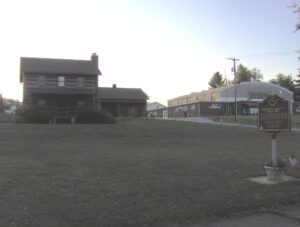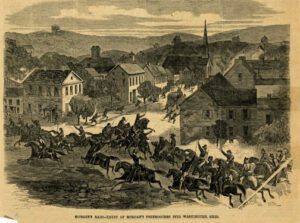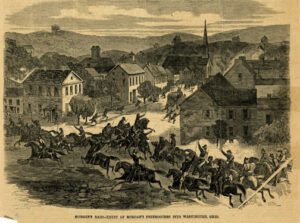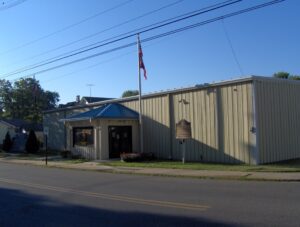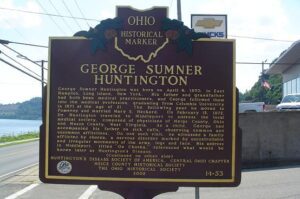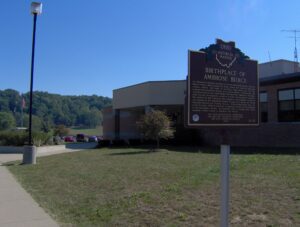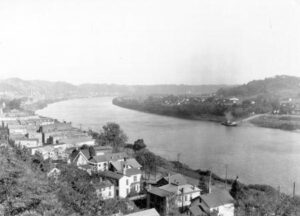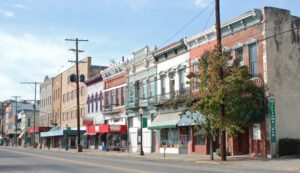, OH
Surgeon and songwriter Brewster Higley VI was born in Rutland in 1823, the grandson of Brewster Higley IV, a veteran of the American Revolution and founder of Rutland. Higley began studying medicine at age 18 and opened his first practice in Pomeroy, moving to Indiana and then to Kansas in 1871. The following year he penned the words to the famous Western song, “Home on the Range.” This perennial favorite became the state song of Kansas in 1947. Oh, give me a home where the buffalo roam, And the deer and the antelope play, Where seldom is heard a discouraging word, And the skies are not cloudy all day.
, OH
General John Hunt Morgan led 2,000 Confederate cavalrymen into Meigs County on July 18, 1863, during a 45-day raid north of the Ohio River. In pursuit, Union forces under Gen. James M. Shackelford and Col. Frank L. Wolford deployed near Bashan Church on the morning of July 19. Near this point five regiments of Kentucky cavalry and the 45th Ohio Mounted Infantry met Confederates retreating from the battle at Buffington Island, three miles east. During this skirmish, Confederate Colonels Richard C. Morgan, William W. Ward, and D. Howard Smith surrendered their commands, numbering about 400 men and officers.
, OH
As Morgan’s Raiders rode eastward across southern Ohio during the third week of July 1863, the scattered defensive forces pursuing him consolidated and drew closer. Four regiments under Brigadier General Eliakim P. Scammon (including the 23rd Ohio, containing future U.S. Presidents Rutherford B. Hayes and William McKinley Jr.) arrived here by steamboat on July 18, preventing Morgan from entering Pomeroy. Brigadier General Henry Moses Judah’s division also arrived in Pomeroy on July 18, immediately marching east following Morgan. Following Morgan’s defeat at Buffington Island on July 19, both Judah and Brigadier General Edward H. Hobson returned to Pomeroy and headquartered at the Grand Dilcher Hotel. Of the approximately 900 Confederate prisoners captured in Meigs County, 227 were held here at the courthouse before being sent downriver to Cincinnati.
, OH
General James V. Hartinger, 1925-2000, was born in Middleport, Ohio, and graduated from Middleport High School in 1943. He graduated from the United States Military Academy at West Point in 1949 and was a career-long fighter pilot with the United States Air Force, flying every type of fighter craft the Air Force procured during his 35 years of active duty. He saw military action during World War II, the Korean War, and the Vietnam War. Named commander-in-chief of the North American Aerospace Defense Command (NORAD) in Colorado Springs in 1979, he was promoted to four stars and became the “founding father” of Air Force Space Command. The headquarters building of Air Force Space Command is named the James V. Hartinger Building in his honor and the Hartinger Medal is awarded annually for extraordinary achievement in space.
, OH
George Sumner Huntington was born on April 9, 1850, in East Hampton, Long Island, New York. His father and grandfather had both been medical practitioners, and George followed them into the medical profession, graduating from Columbia University in 1871 at the age of 21. The following year he moved to Pomeroy and married Mary E. Heckard. On February 15, 1872, Dr. Huntington traveled to Middleport to address the local medical society, composed of physicians of Meigs County, Ohio and Mason County, West Virginia. As a child, George had accompanied his father on sick calls, observing common and uncommon afflictions. On one such visit, he witnessed a family afflicted by chorea, a nervous disorder marked by uncontrollable and irregular movements of the arms, legs, and face. His address in Middleport, titled “On Chorea,” referenced what would be known later as Huntington’s Disease. (continued on other side)
, OH
An influential American journalist of the late nineteenth century, Ambrose Bierce (1842 – c. 1914) was born in Meigs County and reared in Kosciusko County, Indiana. He fought in the Union Army during the Civil War, a formative experience related in his short stories “Chickamauga” and “An Occurrence at Owl Creek Bridge.” Moving to San Francisco in the years after the war, he began his career as a writer and newspaper columnist. His cynical wit and elaborate puns reached a wide audience during the last quarter of the nineteenth century through such papers as William Randolph Hearst’s San Francisco Examiner. Bierce’s best-known book, the Devil’s Dictionary (1911), is a lexicon of humorous definitions first published in his newspaper columns. In December 1913 or January 1914, Bierce vanished during travels in rebellion-torn Mexico.
, OH
The Ohio River begins at the confluence of the Allegheny and Monongahela rivers in Pittsburgh, Pennsylvania, and flows 981 miles to join the Mississippi River at Cairo, Illinois. The Iroquois called the river “Oyo” or “Ohio,” which the French translated as “La Belle Riviere,” the Beautiful River. It was an important transportation route for countless generations of Native Americans and, beginning in the 1780s, for Euro-American settlers. It was the main route to the opening West and the principal outlet for the region’s growing farm output. Congress first acted to improve navigation in 1824 and, later, by canalizing the river with a series of locks and dams beginning in 1878. River commerce has increased with industrialization, moving up to 150 million tons annually.
, OH
Since it was formed in 1819, Meigs County was fostered by its location on 57 miles of the Ohio River, named by the Indians”Oyo,” meaning beautiful river. Pomeroy, the county seat, was named for Samuel Wyllys Pomeroy, an early landholder. His company, Pomeroy, Sons & Company, and his son-in-law, Valentine B. Horton (1802-1888), were influential in developing the coal, salt, and iron industries of the region. Horton pioneered the transportation of coal by river, building the world’s first coal barges and, in 1835, the first coal-fueled towboat, the Condor. Coal, salt, and iron, in addition to other local products, were shipped from Pomeroy’s 125′ x 40′ wharf to ports from Pittsburgh to Cincinnati. Excursion, passenger, shanty and showboats also visited Pomeroy’s port. Today, the Ohio River continues to be a busy waterway carrying commodities such as coal, petroleum, chemicals, steel, sand, and gravel. It is also a busy haven for recreational crafts as well as stern wheel boats.


